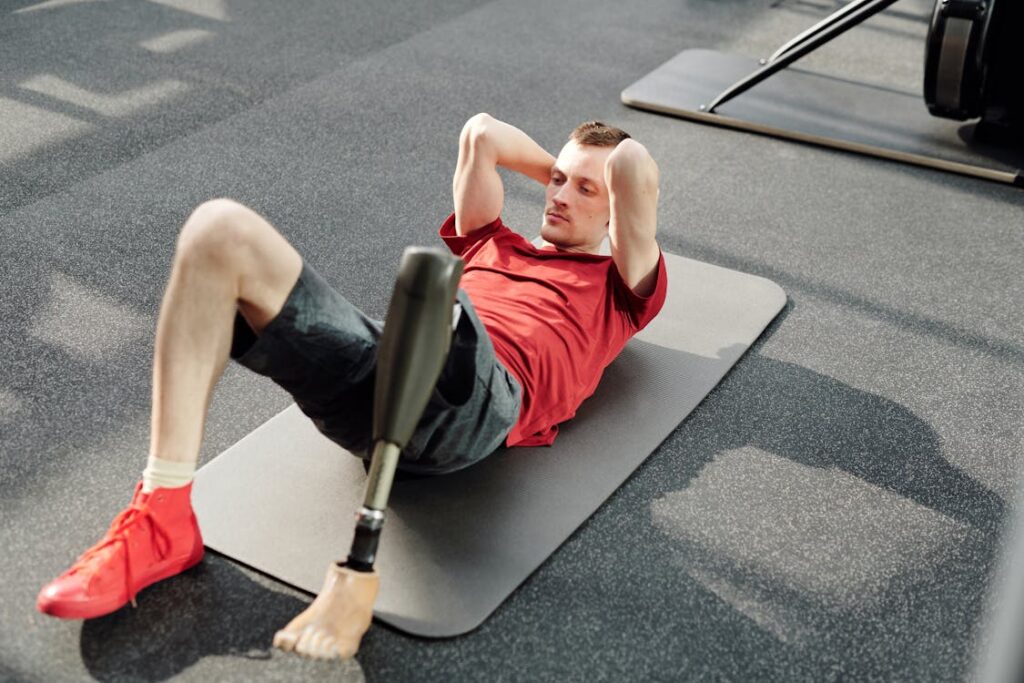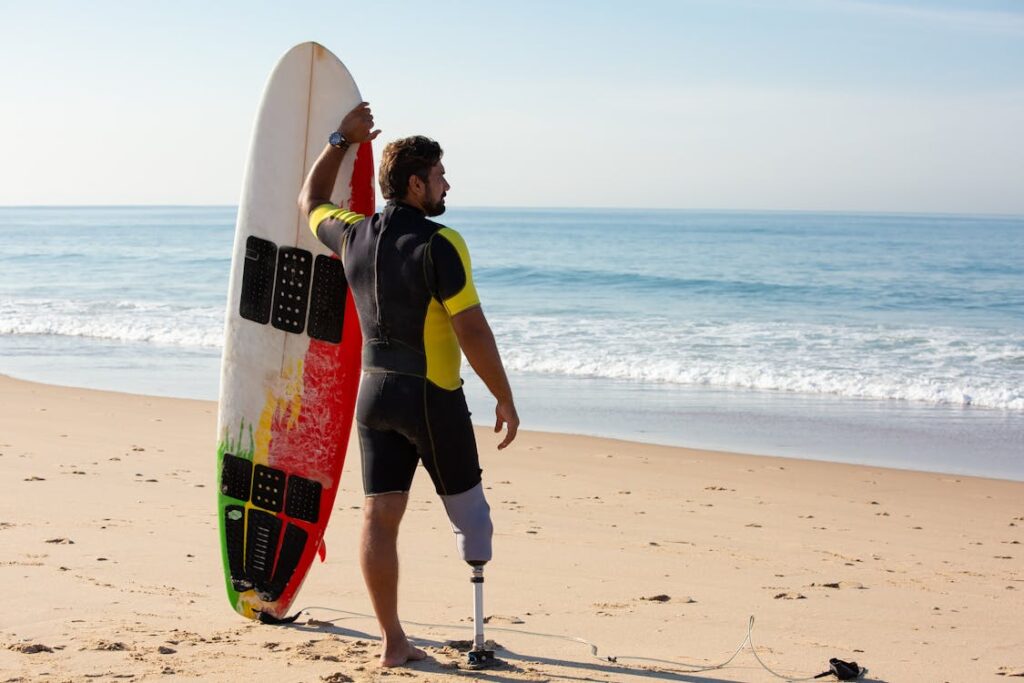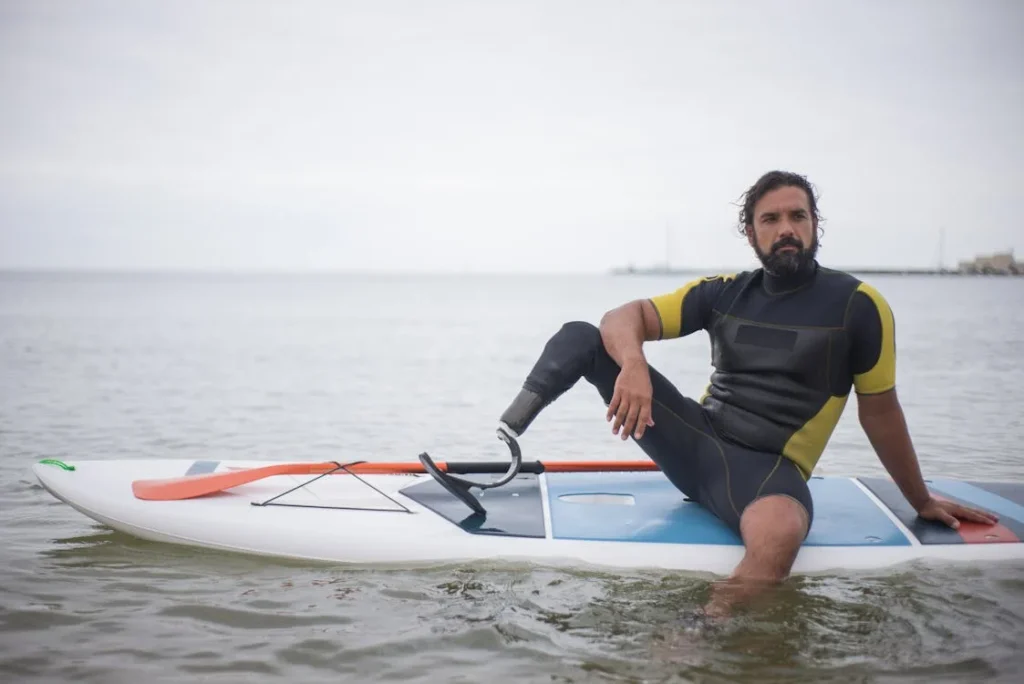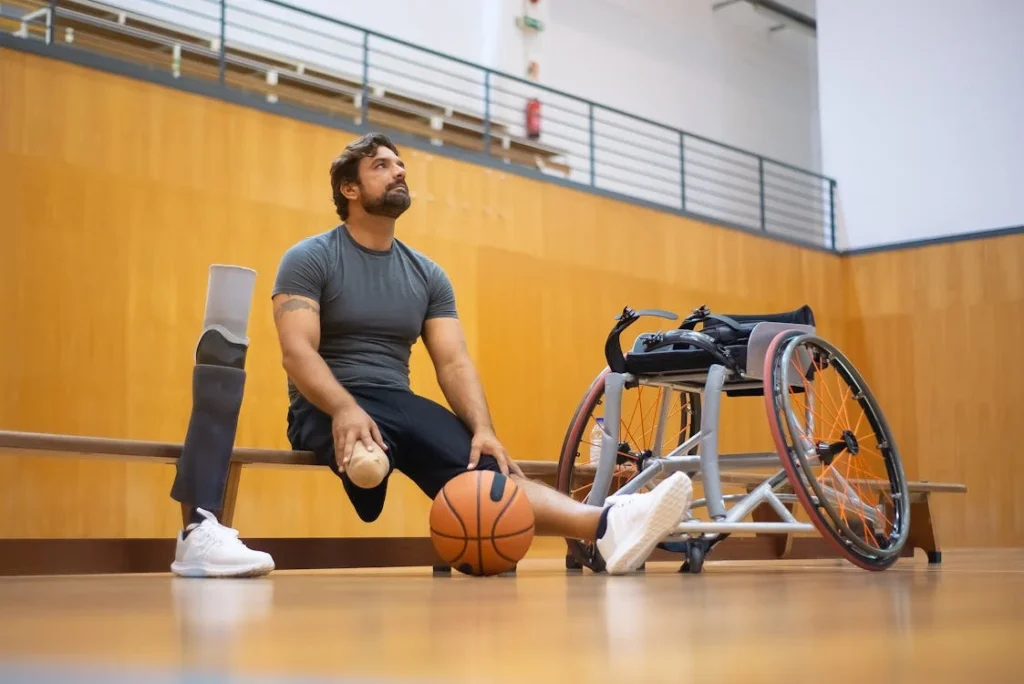Adjusting to a prosthetic is a journey that goes beyond just learning how to use it—it also involves building confidence in yourself. While a prosthetic is designed to help you regain mobility and independence, the process of adapting to it can bring moments of frustration, uncertainty, and self-doubt. It is completely natural to wonder, Will I ever get used to this? or What if I never feel comfortable using it?
Self-doubt is a common part of the learning process, but it does not have to hold you back. The way you think about your prosthetic and your ability to adapt can make a huge difference in how quickly you adjust. Confidence is built over time, through patience, practice, and the right mindset.

Understanding Self-Doubt and Why It Happens
Self-doubt often appears when you are stepping into something new and unfamiliar. When learning to use a prosthetic, it is common to feel uncertain, especially if movements feel unnatural or progress seems slow.
Understanding why these feelings arise can help you manage them more effectively.
Adjusting to Change Takes Time
The body and mind take time to adapt to a prosthetic. At first, it may feel strange, uncomfortable, or even frustrating. If you have been without a limb for a while, your brain has adjusted to functioning in a different way.
Now, it needs to relearn how to move with the prosthetic as part of your body. This process takes patience. It is normal for certain tasks to feel challenging at first, but with practice, they become easier.
Many people experience doubt when they compare their current ability to how they used to move before.
Instead of thinking, “I can’t do this like I used to,” shift your focus to, “I am learning a new way to do this.” Progress may be gradual, but every small improvement means you are moving forward.
Fear of Failure Can Hold You Back
One of the biggest sources of self-doubt is the fear of making mistakes. You may worry about dropping objects with a prosthetic hand, struggling with balance while using a prosthetic leg, or not getting movements right.
The truth is, mistakes are part of the learning process. Just like learning to walk, write, or drive, mastering a prosthetic takes repetition and adjustment.
Instead of seeing challenges as failures, view them as opportunities to improve. Each mistake teaches you something new about how to control your prosthetic, how to move more comfortably, and how to make adjustments that work for you.
The more you practice, the more natural it will feel.
Comparing Yourself to Others Can Be Discouraging
It is easy to look at others who have mastered their prosthetic and think, “Why is it taking me so long?” But every person’s journey is different.
Some people adapt quickly, while others take more time. Factors like muscle strength, nerve sensitivity, and how long you have been without a limb all affect the adjustment period.
Instead of comparing your progress to someone else’s, focus on your own improvements. What were you able to do today that you struggled with last week? Recognizing small wins helps build confidence and reminds you that you are making progress, even if it feels slow.
Doubt Can Be Replaced with Trust
Self-doubt often comes from a lack of trust—in your prosthetic, in your body’s ability to adapt, and in yourself. But trust is something that is built over time. The more you use your prosthetic, the more comfortable and natural it will feel.
At the start, it may seem like your prosthetic is something separate from you. But as you train your muscles and brain to work with it, it becomes an extension of your body. Trust the process, trust your abilities, and remind yourself that every day you are getting stronger.

Building Confidence Through Practice and Patience
Confidence is not something that appears overnight—it is developed through consistent effort, patience, and self-trust.
The more you practice using your prosthetic, the more natural it will feel. While the journey may have ups and downs, every small step forward is proof that you are improving.
Starting with Small, Achievable Goals
One of the best ways to overcome self-doubt is to focus on small goals. Instead of thinking about mastering every movement at once, break your progress into steps.
If you are learning to use a prosthetic leg, start by standing comfortably before moving on to short walks. If you have a prosthetic hand, focus on grasping light objects before attempting more complex tasks.
Each time you accomplish a small goal, your confidence grows. The feeling of success, even in tiny achievements, reinforces the idea that you can adapt. Over time, these small victories add up, and what once felt difficult will become second nature.
Repetition Helps Build Muscle Memory
At first, using a prosthetic requires conscious effort. You have to think about every movement, which can be tiring.
However, the more you practice, the more automatic these actions become. Your brain and muscles start working together, making movements smoother and more natural.
Repetition helps create muscle memory. This is why daily practice is important, even if it is just for a few minutes.
The more you use your prosthetic in everyday activities—such as picking up objects, walking short distances, or adjusting to different surfaces—the easier it will feel over time.
Accepting Frustration as Part of the Process
There will be days when things do not go as planned. Some movements might feel harder than expected, and certain tasks may take longer to master. It is natural to feel frustrated, but the key is not to let those moments discourage you.
When frustration arises, take a deep breath and remind yourself why you started. Progress is not always visible right away, but that does not mean it is not happening. Every challenge you push through makes you stronger and more capable.
Trusting Your Prosthetic as an Extension of Yourself
At the beginning, a prosthetic may feel like something separate from your body. It takes time to learn how to move with it naturally. However, with regular use, you will start to trust it more. The more you use it in different situations, the more confidence you will have in its reliability.
If you are struggling with discomfort or fit issues, do not hesitate to seek adjustments from your prosthetist. A well-fitted prosthetic can make a huge difference in how comfortable and confident you feel while using it.
Learning to trust your prosthetic is a key step in overcoming self-doubt and fully integrating it into your daily life.

Shifting Your Mindset: From Doubt to Determination
Your thoughts have a powerful impact on your progress. If you constantly tell yourself that using a prosthetic is too difficult, your brain will believe it.
But if you shift your thinking toward possibilities rather than limitations, you will start to see improvement in both your confidence and ability.
Focusing on What You Can Do Instead of What You Can’t
Self-doubt often comes from comparing your current abilities to what you could do before. Instead of focusing on what has changed, shift your attention to what you are learning. Every time you practice using your prosthetic, you are gaining new skills.
Instead of saying, “I can’t do this like I used to,” try thinking, “I am learning a new way to do this.” Instead of saying, “This is too hard,” remind yourself, “With practice, this will get easier.”
Training your mind to focus on progress instead of setbacks will make a huge difference in how you approach challenges.
Reframing Setbacks as Learning Opportunities
There will be moments when using your prosthetic feels frustrating. Maybe you drop an object, lose balance, or struggle with a particular movement.
Instead of seeing these moments as failures, try looking at them as learning experiences. Each challenge teaches you something new about how to adjust, adapt, and improve.
When something does not go as planned, ask yourself, “What can I learn from this?” This shift in thinking turns frustration into motivation. You start to see setbacks not as proof that you are failing, but as steps toward mastery.
Visualizing Success to Strengthen Your Confidence
Visualization is a powerful mental tool. Many athletes use it to improve their performance, and it can be just as effective when learning to use a prosthetic.
Before attempting a movement, take a moment to picture yourself doing it successfully. Imagine yourself walking smoothly, grasping an object effortlessly, or moving with confidence.
When you mentally rehearse success, your brain starts to believe it is possible. This technique helps reduce anxiety and builds trust in your ability to perform tasks. The more you visualize success, the more natural it will feel when you actually attempt the movement.
Surrounding Yourself with Positive Reinforcement
The people around you can influence your mindset. If you have a strong support system—family, friends, therapists, or peers who encourage you—it becomes easier to stay motivated. Surround yourself with people who believe in your ability to improve.
If you ever feel discouraged, talking to someone who understands can help. Whether it is another prosthetic user, a support group, or a rehabilitation specialist, connecting with others who have been through a similar journey can remind you that you are not alone.
By shifting your mindset from self-doubt to self-belief, you are setting yourself up for success. Confidence is built step by step, and with the right perspective, you can turn every challenge into an opportunity for growth.

Turning Practice into Progress: Making Your Prosthetic a Natural Part of Your Life
Overcoming self-doubt is not just about thinking positively—it is about taking action. The more you use your prosthetic in daily life, the more natural it will feel. Integrating it into everyday activities builds familiarity, comfort, and confidence.
Using Your Prosthetic in Everyday Tasks
One of the best ways to build confidence is by using your prosthetic in simple, routine activities. If you have a prosthetic hand, start by picking up lightweight objects, holding a cup, or using it to assist your other hand.
If you are learning to use a prosthetic leg, practice standing, shifting your weight, and walking short distances around the house.
Repetition is key. The more often you engage with your prosthetic, the faster your brain and body will adapt. These small, consistent efforts turn practice into progress. Over time, movements that once felt difficult will become second nature.
Exploring Different Environments and Activities
It is common to feel comfortable using a prosthetic in a controlled space, like at home or in a rehabilitation center, but stepping into new environments can feel intimidating.
Walking on different surfaces, navigating crowded areas, or using your prosthetic in social settings may bring up feelings of doubt.
The best way to overcome this is through gradual exposure. If walking in public feels overwhelming, start by taking short walks outside.
If using your prosthetic in social situations feels awkward, practice simple tasks around family and close friends first. Expanding your comfort zone slowly will help you gain confidence in real-world settings.
Adapting to Challenges with a Problem-Solving Mindset
Everyday life presents different challenges, and at times, using a prosthetic may require creative problem-solving. Instead of seeing an obstacle as a reason to doubt yourself, approach it with curiosity.
Ask yourself, “How can I adjust?” or “What small change can make this easier?”
Sometimes, small modifications—like adjusting the fit of a prosthetic, changing the angle of movement, or using adaptive tools—can make a big difference.
The more you experiment and find solutions that work for you, the more control you gain over your prosthetic and your daily experiences.
Celebrating Progress, No Matter How Small
It is easy to focus on what is still difficult, but recognizing your progress is just as important. Every improvement—no matter how minor—proves that you are moving forward.
Whether it is walking a little farther, gripping an object more easily, or simply feeling less hesitation when using your prosthetic, these are all signs of growth.
Confidence comes from repeated success, and success comes from practice. The more you engage with your prosthetic, challenge yourself in new environments, and find ways to adapt, the more natural it will feel. Each day, you are proving to yourself that you can do this.

Finding Support and Inspiration from Others
Overcoming self-doubt is easier when you realize that you are not alone. Many people have gone through the same journey of adjusting to a prosthetic, facing challenges, and learning to trust themselves again.
Connecting with others who have been in your shoes can provide motivation, practical advice, and reassurance that progress is always possible.
Learning from People Who Have Mastered Their Prosthetic
Seeing others who have successfully adapted to their prosthetic can be incredibly inspiring.
Whether it is an athlete competing with a prosthetic leg, an artist using a prosthetic hand, or someone confidently going about their daily life, their success proves that challenges can be overcome.
If you do not know anyone personally, online communities and social media platforms offer a way to connect with people who share their experiences.
Many individuals post videos of their progress, tips for adjusting to different situations, and personal stories about how they built their confidence. Watching others succeed can remind you that you are capable of achieving the same.
Joining Support Groups and Rehabilitation Programs
Support groups—whether in person or online—provide a space to share experiences, ask questions, and learn from others who understand what you are going through.
Speaking with people who have faced similar struggles can be comforting and motivating. They can offer practical solutions for common challenges, as well as emotional encouragement when self-doubt creeps in.
Many rehabilitation programs also include group training sessions or therapy designed to help people adjust to prosthetics.
These sessions not only improve physical skills but also create an environment of shared support, where you can connect with others who are at different stages of their journey.
Working with Experts Who Can Guide You
Physical therapists, prosthetists, and occupational therapists are there to help you succeed. If you feel stuck or unsure about your progress, talking to a professional can provide clarity and reassurance.
They can offer personalized guidance, suggest modifications to improve comfort, and help you refine your movements.
Sometimes, self-doubt comes from a lack of information or uncertainty about whether you are using your prosthetic correctly. Asking questions, seeking adjustments, and getting expert feedback can remove that uncertainty and give you the confidence to move forward.
Finding Encouragement in Your Own Journey
While connecting with others is valuable, your biggest source of encouragement should come from within. Looking back at how far you have come—even if progress feels slow—can remind you that you are constantly improving.
Each challenge you overcome, each time you push past self-doubt, and each day you continue to use your prosthetic is proof of your strength.
With the right mindset, support, and determination, you can turn doubt into confidence and continue building a future where you feel fully in control of your abilities.

Turning Doubt into Determination: Embracing Your Journey
Self-doubt may appear at different stages of your journey, but what matters is how you respond to it. Instead of letting it hold you back, you can turn that doubt into determination.
The process of learning to use a prosthetic is not just about physical ability—it is about mindset, resilience, and self-belief. By embracing the journey with a positive and determined attitude, you can push through obstacles and discover just how strong you truly are.
Viewing Every Challenge as a Step Forward
Every time you struggle with a movement, it is not a sign of failure—it is a step toward improvement. Challenges force you to adapt, refine your technique, and strengthen your body and mind. Instead of fearing difficulties, try to welcome them as opportunities to grow.
The more you face challenges head-on, the less intimidating they become.
If a certain movement feels difficult today, remind yourself that it will feel easier in the future with continued effort. Your body and brain are constantly learning. Each attempt, even if it is not perfect, brings you closer to mastering your prosthetic.
Developing a “Keep Going” Mentality
Determination comes from persistence. The people who succeed in rehabilitation are not necessarily the ones who progress the fastest, but the ones who keep going no matter what.
On days when you feel discouraged, remind yourself why you started. Think about what you want to achieve—whether it is walking confidently, holding objects with ease, or simply feeling comfortable in your prosthetic.
A “keep going” mentality means accepting that some days will be harder than others but pushing forward anyway. It means refusing to let frustration stop you.
If progress feels slow, focus on consistency. Even small efforts add up over time, leading to big improvements in the long run.
Using Self-Doubt as Fuel for Growth
Doubt can either hold you back or push you forward—it depends on how you use it. Instead of seeing self-doubt as a reason to give up, use it as motivation. Prove to yourself that you are stronger than the doubts in your mind. The best way to do this is through action.
Each time you practice, you are showing yourself that you are capable. Each time you try again after a setback, you are proving your resilience. Over time, this builds a deep inner strength that carries into every aspect of your life.
Embracing the Journey, Not Just the Destination
The goal of rehabilitation is not just to master your prosthetic but to enjoy the process of growth along the way. Every moment of effort, every breakthrough, and even every frustration is part of your unique journey.
Accepting the ups and downs with an open mind will make the experience less stressful and more rewarding.
Instead of only focusing on the end goal, take pride in the progress you make each day. Every time you move with more confidence, every time you feel less hesitation, and every time you push through doubt, you are proving to yourself that you are capable of great things.
Your journey with a prosthetic is one of transformation, and the most important part of that transformation is not just your ability to use the device—it is the strength, determination, and self-belief that you gain along the way.
Conclusion
Overcoming self-doubt when learning to use a prosthetic is not about being perfect—it is about believing in your ability to adapt. Every challenge you face, every moment of frustration, and every small success is shaping you into a stronger, more capable version of yourself.
Doubt may come and go, but what truly matters is how you respond to it. By shifting your mindset, staying consistent, and trusting the process, you will find that what once seemed impossible becomes second nature. Your prosthetic is not a limitation—it is a tool that helps you regain control over your life.
If you are looking for advanced prosthetic solutions that are comfortable, easy to use, and designed to support your rehabilitation journey, Robobionics is here to help. Our innovative prosthetics, including Grippy™, our advanced bionic hand, are built to restore independence and confidence. Book a free demo today and take the next step toward a stronger, more empowered future.
Believe in yourself. You are stronger than your doubts—and your future is full of possibilities.



